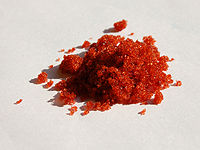Cobalt(II) nitrate
 |
|
| Names | |
|---|---|
| Other names
Cobaltous nitrate
Nitric acid, cobalt(2+) salt |
|
| Identifiers | |
|
3D model (JSmol)
|
|
| ChEBI | |
| ChemSpider | |
| ECHA InfoCard | 100.030.353 |
| EC Number | 233-402-1 |
|
PubChem CID
|
|
| RTECS number | GG1109000 |
| UNII | |
|
|
|
|
| Properties | |
| Co(NO3)2 | |
| Molar mass | 182.943 g/mol (anhydrous) 291.03 g/mol (hexahydrate) |
| Appearance | pale red powder (anhydrous) red crystalline (hexahydrate) |
| Odor | odorless (hexahydrate) |
| Density | 2.49 g/cm3 (anhydrous) 1.87 g/cm3 (hexahydrate) |
| Melting point | 100 °C (212 °F; 373 K) decomposes (anhydrous) 55 °C (hexahydrate) |
| Boiling point | 100 to 105 °C (212 to 221 °F; 373 to 378 K) decomposes (anhydrous) 74 °C, decomposes (hexahydrate) |
|
anhydrous: 84.03 g/100 mL (0 °C) 334.9 g/100 mL (90 °C) soluble (anhydrous) |
|
| Solubility | soluble in alcohol, acetone, ethanol, ammonia (hexahydrate), methanol 2.1 g/100 mL |
| Structure | |
| monoclinic (hexahydrate) | |
| Hazards | |
| Safety data sheet | Cobalt (II) Nitrate MSDS |
|
EU classification (DSD) (outdated)
|
Carc. Cat. 2 Muta. Cat. 3 Repr. Cat. 2 Toxic (T) Dangerous for the environment (N) |
| R-phrases (outdated) | R49, R60, R42/43, R68, R50/53 |
| S-phrases (outdated) | S53, S45, S60, S61 |
| NFPA 704 | |
| Lethal dose or concentration (LD, LC): | |
|
LD50 (median dose)
|
434 mg/kg; rat, oral (anhydrous) 691 mg/kg; rat, oral (hexahydrate) |
| Related compounds | |
|
Other anions
|
Cobalt(II) sulfate Cobalt(II) chloride Cobalt oxalate |
|
Other cations
|
Iron(III) nitrate Nickel(II) nitrate |
|
Except where otherwise noted, data are given for materials in their standard state (at 25 °C [77 °F], 100 kPa).
|
|
|
|
|
| Infobox references | |
Cobalt Nitrate is the inorganic cobalt(II) salt of nitric acid, often with various amounts of water. It is more commonly found as a hexahydrate, Co(NO3)2·6H2O, which is a red-brown deliquescent salt that is soluble in water and other polar solvents.
As well as the anhydrous compound Co(NO3)2, several hydrates of cobalt(II) nitrate exist. These hydrates have the chemical formula Co(NO3)2·nH2O, where n = 0, 2, 4, 6.
Anhydrous cobalt(II) nitrate adopts a three-dimensional polymeric network structure, with each cobalt(II) atom approximately octahedrally coordinated by six oxygen atoms, each from a different nitrate ion. Each nitrate ion coordinates to three cobalts. The dihydrate is a two-dimensional polymer, with nitrate bridges between Co(II) centres and hydrogen bonding holding the layers together. The tetrahydrate consists of discrete, octahedral [(H2O)4Co(NO3)2] molecules. The hexahydrate is better described as hexaaquacobalt(II) nitrate, [Co(OH2)6][NO3]2, as it consists of discrete [Co(OH2)6]2+ and [NO3]− ions. Above 55 °C, the hexahydrate converts to the trihydrate and at higher temperatures to the monohydrate.
It is commonly reduced to metallic high purity cobalt. It can be absorbed on to various catalyst supports for use in Fischer-Tropsch catalysis. It is used in the preparation of dyes and inks.
The hexahydrate is prepared treating metallic cobalt or one of its oxides, hydroxides, or carbonate with nitric acid:
...
Wikipedia

